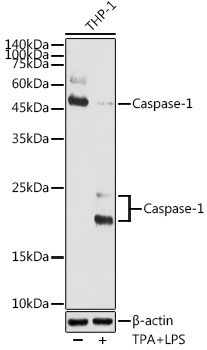Cell Death Antibodies 2
Anti-Caspase-1 Antibody (CAB16792)
- SKU:
- CAB16792
- Product Type:
- Antibody
- Reactivity:
- Human
- Reactivity:
- Mouse
- Host Species:
- Rabbit
- Isotype:
- IgG
- Antibody Type:
- Polyclonal Antibody
- Research Area:
- Cell Death
Description
| Antibody Name: | Anti-Caspase-1 Antibody |
| Antibody SKU: | CAB16792 |
| Antibody Size: | 20uL, 50uL, 100uL |
| Application: | WB |
| Reactivity: | Human, Mouse |
| Host Species: | Rabbit |
| Immunogen: | Recombinant protein of human Caspase-1. |
| Application: | WB |
| Recommended Dilution: | WB 1:500 - 1:2000 |
| Reactivity: | Human, Mouse |
| Positive Samples: | THP-1 |
| Immunogen: | Recombinant protein of human Caspase-1. |
| Purification Method: | Affinity purification |
| Storage Buffer: | Store at -20°C. Avoid freeze / thaw cycles. Buffer: PBS with 0.02% sodium azide, 50% glycerol, pH7.3. |
| Isotype: | IgG |
| Sequence: | Email for sequence |
| Gene ID: | 834 |
| Uniprot: | P29466 |
| Cellular Location: | Cytoplasm |
| Calculated MW: | 10kDa/29kDa/35kDa/42kDa/45kDa |
| Observed MW: | 48KDa/20-25KDa |
| Synonyms: | CASP1, ICE, IL1BC, P45, caspase-1, Caspase 1 |
| Background: | This gene encodes a protein which is a member of the cysteine-aspartic acid protease (caspase) family. Sequential activation of caspases plays a central role in the execution-phase of cell apoptosis. Caspases exist as inactive proenzymes which undergo proteolytic processing at conserved aspartic residues to produce 2 subunits, large and small, that dimerize to form the active enzyme. This gene was identified by its ability to proteolytically cleave and activate the inactive precursor of interleukin-1, a cytokine involved in the processes such as inflammation, septic shock, and wound healing. This gene has been shown to induce cell apoptosis and may function in various developmental stages. Studies of a similar gene in mouse suggest a role in the pathogenesis of Huntington disease. Alternative splicing results in transcript variants encoding distinct isoforms. |
| UniProt Protein Function: | CASP1: Thiol protease that cleaves IL-1 beta between an Asp and an Ala, releasing the mature cytokine which is involved in a variety of inflammatory processes. Important for defense against pathogens. Cleaves and activates sterol regulatory element binding proteins (SREBPs). Can also promote apoptosis. Heterotetramer that consists of two anti-parallel arranged heterodimers, each one formed by a 20 kDa (p20) and a 10 kDa (p10) subunit. The p20 subunit can also form a heterodimer with the epsilon isoform which then has an inhibitory effect. May be a component of the inflammasome, a protein complex which also includes PYCARD, CARD8 and NALP2 and whose function would be the activation of proinflammatory caspases. Interacts with CARD17/INCA and CARD18. Expressed in larger amounts in spleen and lung. Detected in liver, heart, small intestine, colon, thymus, prostate, skeletal muscle, peripheral blood leukocytes, kidney and testis. No expression in the brain. Specifically inhibited by the cowpox virus Crma protein. Belongs to the peptidase C14A family. 5 isoforms of the human protein are produced by alternative splicing. |
| UniProt Protein Details: | Protein type:Apoptosis; Protease; EC 3.4.22.36 Chromosomal Location of Human Ortholog: 11q23 Cellular Component: cytoplasm; extracellular region; cytosol Molecular Function:protein binding; cysteine-type endopeptidase activity; endopeptidase activity; caspase activator activity Biological Process: caspase activation; positive regulation of I-kappaB kinase/NF-kappaB cascade; apoptosis; membrane hyperpolarization; interleukin-1 beta production; response to lipopolysaccharide; positive regulation of interleukin-1 beta secretion; mitochondrial depolarization; proteolysis; signal transduction; response to ATP; positive regulation of interleukin-1 alpha secretion; regulation of inflammatory response; response to hypoxia; innate immune response; regulation of autophagy |
| NCBI Summary: | This gene encodes a protein which is a member of the cysteine-aspartic acid protease (caspase) family. Sequential activation of caspases plays a central role in the execution-phase of cell apoptosis. Caspases exist as inactive proenzymes which undergo proteolytic processing at conserved aspartic residues to produce 2 subunits, large and small, that dimerize to form the active enzyme. This gene was identified by its ability to proteolytically cleave and activate the inactive precursor of interleukin-1, a cytokine involved in the processes such as inflammation, septic shock, and wound healing. This gene has been shown to induce cell apoptosis and may function in various developmental stages. Studies of a similar gene in mouse suggest a role in the pathogenesis of Huntington disease. Alternative splicing results in transcript variants encoding distinct isoforms. [provided by RefSeq, Mar 2012] |
| UniProt Code: | P29466 |
| NCBI GenInfo Identifier: | 266321 |
| NCBI Gene ID: | 834 |
| NCBI Accession: | P29466.1 |
| UniProt Secondary Accession: | P29466,Q53EY6, Q6DMQ1, Q6GSS3, Q6PI75, Q9UCN3, B5MDZ1 |
| UniProt Related Accession: | P29466 |
| Molecular Weight: | 10,417 Da |
| NCBI Full Name: | Caspase-1 |
| NCBI Synonym Full Names: | caspase 1, apoptosis-related cysteine peptidase |
| NCBI Official Symbol: | CASP1 |
| NCBI Official Synonym Symbols: | ICE; P45; IL1BC |
| NCBI Protein Information: | caspase-1; IL1B-convertase; CASP1 nirs variant 1; IL-1 beta-converting enzyme; interleukin 1, beta, convertase; interleukin 1-B converting enzyme; caspase 1, apoptosis-related cysteine peptidase (interleukin 1, beta, convertase) |
| UniProt Protein Name: | Caspase-1 |
| UniProt Synonym Protein Names: | Interleukin-1 beta convertase; IL-1BC; Interleukin-1 beta-converting enzyme; ICE; IL-1 beta-converting enzyme; p45Cleaved into the following 2 chains:Caspase-1 subunit p20; Caspase-1 subunit p10 |
| UniProt Gene Name: | CASP1 |
| UniProt Entry Name: | CASP1_HUMAN |







